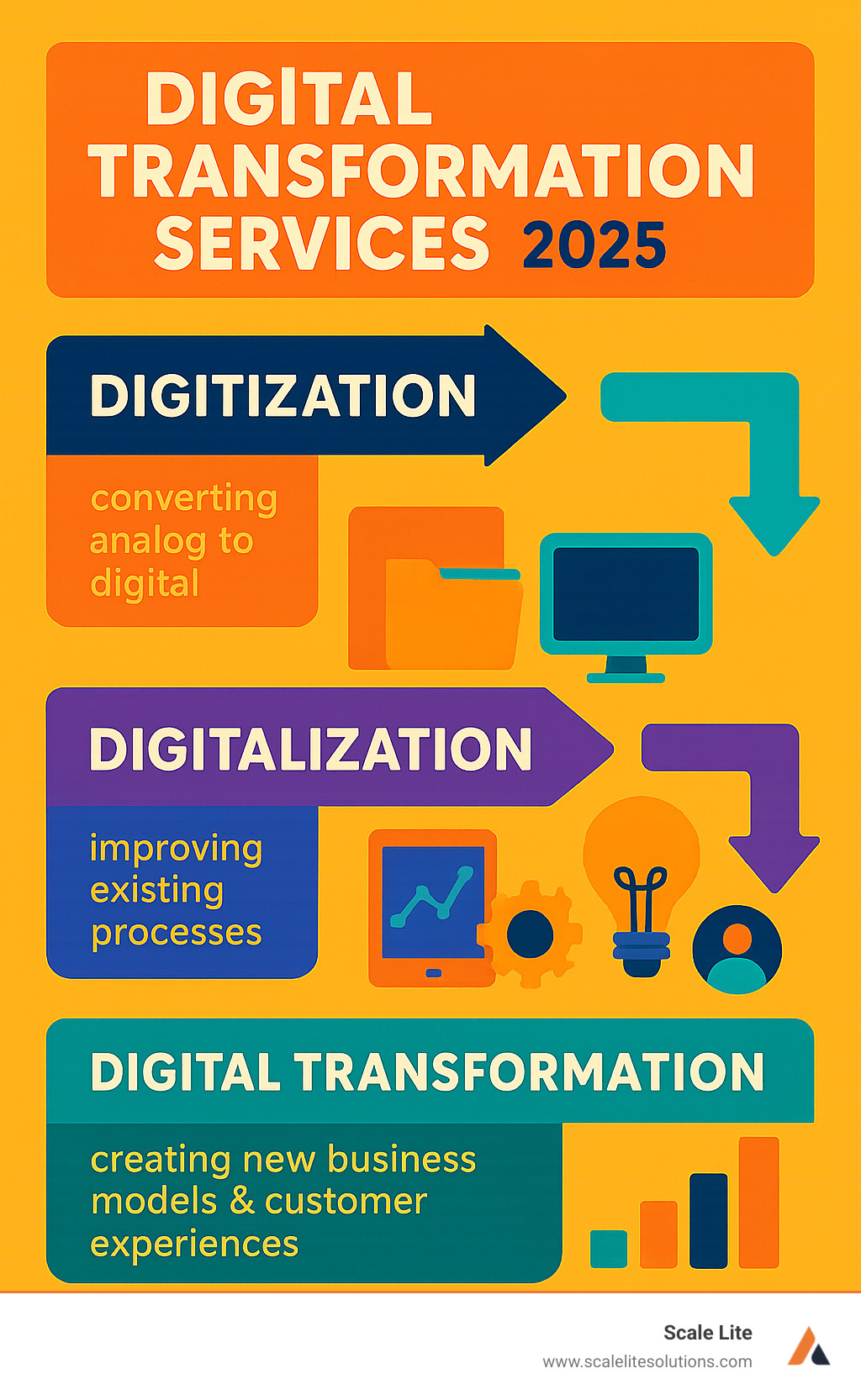
Digital Transformation Demystified: Services That Drive Real Results

What Digital Change Services Really Mean for Your Business
Digital change services are comprehensive solutions that help businesses modernize their operations, improve customer experiences, and drive growth through strategic technology integration. These services encompass everything from process automation and data analytics to cloud migration and AI implementation.
Core Digital Change Services Include:
- Strategic Planning - Developing a roadmap aligned with business goals
- Process Automation - Streamlining workflows and reducing manual tasks
- Technology Integration - Implementing cloud, AI, and data analytics solutions
- Change Management - Supporting teams through organizational transitions
- Legacy System Modernization - Updating outdated systems and processes
- Data Strategy - Creating unified data systems for better decision-making
McKinsey research found that between 2018-2022, digital leaders achieved about 65% greater annual total shareholder returns than companies that lagged behind. Yet many digital change initiatives fail, often because businesses focus on technology instead of strategy.
Digital change isn't just about new software or moving to the cloud. It's about fundamentally rewiring how your business operates to meet modern customer expectations and reduce dependency on manual processes.
For service-based businesses, this means creating documented, scalable systems to move beyond spreadsheets and verbal instructions. It’s the difference between a business that needs you daily and one that runs profitably without you.
I'm Keaton Kay. From my time at DocuSign with enterprise clients to my current work at Scale Lite helping blue-collar service businesses modernize, I've seen how digital change, when done right, creates measurable value. It reduces operational chaos and builds systems for sustainable growth.

Quick Digital change services definitions:
The "What" and "Why" of Digital Change
At its core, digital change is about fundamentally rewiring how your organization operates. It's a strategic initiative that weaves technology into every corner of your business, reimagining your entire operation for the digital age.
For a blue-collar service business, this means replacing manual scheduling on whiteboards with automated systems for bookings and dispatch. It’s about modernizing processes, operations, and culture to enable customer-driven innovation.
Why is this crucial? Survival. Customer expectations are evolving fast, and they demand the ability to do business anytime, anywhere. If you don't meet these expectations, a competitor will.
Core Domains of a Change Strategy
Successful digital change services touch every part of your business. Understanding the key domains helps you steer the journey effectively.
Business model innovation means rethinking how you deliver value. For example, a cleaning company could offer subscription services or use smart sensors to optimize schedules.
Process optimization makes daily operations smoother. Through business process streamlining, you can automate tasks like invoicing and scheduling, freeing up your team to focus on customers.
Customer experience focuses on seamless, personalized interactions. This includes user-friendly online booking, automated reminders, and instant support. As research shows, 73% of customers prefer personalized experiences.
Employee experience is also key. Modern tools that make jobs easier lead to happier, more efficient employees. For instance, technicians can update job statuses and process payments from their phones.
Operational agility is your ability to adapt to change, like reallocating resources during demand spikes or pivoting services. This flexibility is crucial for long-term success.
Key Enabling Technologies
Effective digital change comes from applying the right technologies in smart ways.
Cloud computing provides a flexible online workspace, allowing access to software and data from anywhere. It reduces IT costs and enables remote work.
Artificial Intelligence (AI) and Machine Learning (ML) are about smart automation and pattern recognition. AI can optimize routes, predict maintenance needs, or analyze customer feedback. ML helps these systems improve over time.
AI-driven workflow automation is where AI delivers significant operational efficiency by handling repetitive tasks automatically, freeing up your team for higher-value work.
The Internet of Things (IoT) connects physical objects to the internet. For service businesses, this could mean equipment sensors that predict breakdowns or GPS tracking to optimize routes.
Data and analytics turn business information into actionable insights. It allows you to move beyond gut feelings and use data-driven decision making to understand customers and identify growth opportunities.
Opening Up Tangible Benefits and Measuring Success
What's the payoff for digital change? The benefits are far-reaching, creating real, measurable improvements that lead to a stronger, more profitable business.

Here are the primary benefits organizations can expect:
- Improved Operational Efficiency: Automating tasks and streamlining workflows reduces time spent on routine activities, leading to less paperwork, fewer errors, and more productive teams.
- Improved Customer Satisfaction: Easy interactions, quick responses, and personalized experiences create happier, more loyal customers. In fact, 73% of customers prefer personalized experiences.
- Greater Business Resilience: With cloud-based systems and agile processes, your business can better handle disruptions, adapt quickly, and maintain continuity.
- New Revenue Streams: Digital change can open up new business models, such as offering online courses, digital products, or expanding your service area through digital outreach.
- A More Engaged Workforce: Modern tools and freedom from tedious tasks boost employee morale and productivity. Engaged teams lead to higher performance and profitability.
- Stronger Cybersecurity: Modern digital systems include advanced security features to protect your business and customer data from cyber threats.
How to Measure the ROI of Digital Change Services
Measuring the return on your investment is crucial. We track tangible impact through these key areas:
- Key Performance Indicators (KPIs): Specific metrics aligned with your goals, like "average customer inquiry resolution time."
- Financial Metrics: Concrete numbers like cost reduction, revenue growth, profitability, and Return on Investment (ROI).
- Operational Improvements: Quantifiable gains in process efficiency and resource optimization.
- Customer Satisfaction (CSAT): Measured through surveys, online reviews, Net Promoter Score (NPS), and customer retention rates.
- Employee Engagement: Tracked via satisfaction surveys, retention rates, and productivity data.
By focusing on these metrics, we ensure your investment in digital change services is a powerful engine for growth.
The Impact on People: Customer and Employee Experience
Digital change is ultimately about people—making things better for your customers and your team.
For customers, this means a seamless experience with 24/7 self-service options like online booking. According to one study, 57% of consumers say technology has changed their expectations of companies, and 70% find it easier to switch businesses, making a great customer experience a necessity.
For employees, it means better tools and automated processes that eliminate tedious tasks. This empowerment leads to a happier, more productive team. As Gallup's research on The Benefits of Employee Engagement highlights, this drives profitability. We help you How to Improve Business Performance by ensuring your team becomes your biggest asset.
Your Roadmap to a Successful Change
Starting on digital change services without a clear map can lead you astray. A well-defined roadmap ensures your journey is purposeful and leads to your desired destination.
Successful digital change is a journey, not a destination. It requires a shift in mindset toward continuous evolution. Key elements of the roadmap include:
- Leadership alignment: The starting point. Top management must establish and commit to a clear vision for the change.
- Fostering a digital culture: This is about encouraging innovation, adaptability, and continuous learning, so your team sees change as an opportunity.
- Agile implementation methodology: This breaks the change into small phases, delivering quick wins and allowing for adaptation based on real-world feedback.
- Continuous improvement cycle: This involves ongoing monitoring and optimization, helping you stay ahead of the curve.
Our Digital Change Strategies for Small Businesses guide provides more practical insights.
Critical Leadership Roles and Capabilities
Strong leadership is essential for any digital change services initiative.
- CEO sponsorship and vision: The leader must drive the change and articulate a compelling vision to align the organization.
- Cross-functional teams: These break down silos by bringing together expertise from different departments to ensure solutions meet diverse business needs.
- Developing digital talent: This is about upskilling your current employees in areas like data analysis and automation. The goal is to improve human capabilities, not replace them.
- Effective change management: This puts people first. It involves clear communication and training to ensure your team understands and adopts new processes, helping you become a Hands-Off Business Owner.
Overcoming Common Challenges
Understanding common challenges is the first step to navigating them successfully.
- Lack of a clear strategy: This is a leading cause of failure. The solution is to develop a clear vision aligned with business objectives and an actionable plan.
- Resistance to change: Engage employees early, communicate benefits, and provide training. When people see how changes make their work easier, resistance turns into enthusiasm.
- Data silos: Scattered information prevents a unified view of the business. We implement data strategies to unify information, making it accessible for Data-Driven Decision Making.
- Integrating legacy systems: Older systems can create bottlenecks. We develop a phased modernization plan, prioritizing changes that offer the most immediate value.
- Budget constraints: We focus on high-impact, cost-effective initiatives first. This demonstrates a clear ROI and builds the case for future investments.
For more guidance, see How to Use SOPs for Small Business Digital Change.
Digital Change in Action: Real-World Examples
The best way to understand the power of digital change services is to see them in action. While the principles are universal, let's look at examples and apply them to blue-collar and low-tech industries.
- Retail was revolutionized by e-commerce and personalization. For a service business, this translates to online booking, personalized reminders, and automated CRM systems to track client history.
- Manufacturing uses smart factories and IoT for predictive maintenance and automation. For a service business, this could mean IoT sensors on equipment to predict repairs or smart fleet management to optimize routes.
- Banking shifted from branches to mobile and online services. For your business, this means secure online payments, automated invoicing, and digital record-keeping.
- Service businesses are ripe for digital change, especially with field service automation and CRM solutions. This is our specialty. Imagine a plumbing company using an app for technicians to manage jobs and payments on-site, or a landscaping business using a CRM to automate customer communications.
We help implement these kinds of solutions every day. From AI deployment for optimized scheduling to workflow automation and CRM optimization, we're driving enterprise value for our clients. These changes are designed to make your existing operations smoother and more profitable.
These examples show that digital change services aren't just for tech giants. It's about applying digital solutions to real-world problems, regardless of industry.
For more custom examples custom to smaller operations, check out our insights on Digital Change Examples for Small Business.
Frequently Asked Questions about Digital Change Services
Here are answers to the most common questions we get about digital change services, based on our experience with hundreds of service businesses.
How long does a digital change take?
Digital change isn't a one-time project; it's a continuous process of evolution. The timeline depends on your scope and complexity, but we recommend starting with quick wins rather than a complete overhaul that could take over a year.
By automating your scheduling or communication first, you can see immediate value in just a few weeks. This phased approach builds momentum, delivers tangible results right away, and gets buy-in from your team.
Can a small business afford digital change?
The truth is, small businesses can't afford not to modernize. Otherwise, you risk losing customers to competitors who are easier to do business with.
Digital change doesn't have to be expensive. A smart, scalable approach focuses on high-impact, low-cost areas first. Cloud-based tools are a game-changer, replacing expensive upfront costs with affordable monthly subscriptions. The cost of inaction—manual processes and missed opportunities—is usually far higher than the investment. Our Business Automation Services are designed to deliver quick, self-funding returns.
Do I need an in-house team or can I hire a consultant?
The right choice between an in-house team and a consultant depends on your needs and resources. An in-house team offers deep business knowledge, but finding the right talent can be difficult and expensive. Consultants like us bring broad experience and specialized expertise in areas like AI and automation that are hard to hire for.
We've found a hybrid approach works best. We partner with your team, acting as the architects who build your new digital foundation and then train your people to maintain and expand it. This gives you the best of both worlds: our specialized knowledge combined with long-term internal capability. You can learn more about our partnerships on our About Us page.
Conclusion: Begin Your Change Journey
In today's business world, digital change services are essential for survival and growth. While competitors juggle spreadsheets, you could be running a streamlined operation that practically manages itself.
A thoughtful approach combining people, processes, and technology open ups incredible potential. As we've seen, digital leaders consistently outperform competitors by building more resilient and profitable operations.
For blue-collar and low-tech industries, this is a massive opportunity to leapfrog competitors. By embracing digital change services, you can move beyond manual chaos and build a truly scalable business.
The focus is on tangible value: fewer missed appointments, faster invoicing, and happier customers and employees. It’s about building systems that work for you.
At Scale Lite Solutions, we help businesses like yours steer this journey. Our expertise in AI deployment, workflow automation, and CRM optimization future-proofs your business for sustainable growth. We help transform overworked business owners into leaders of self-sufficient companies.
Don't let complexity intimidate you. The question isn't whether you can afford to modernize – it's whether you can afford not to.
Ready to stop working in your business and start working on it? Let's partner together to achieve operational excellence with AI-powered automation and open up your business's full potential.







